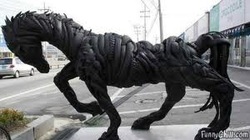
Throughout
the world takes part a continuous process of accumulation of used tires, and
each year their volume increases by about 10-15 million tons, and only about
20% of their number are recycled. The number of stored in the world landfills
tires is more than a billion pieces.
Stiff competition for quality and reliability has led to the composition and properties of rubber, carcass materials, and technology of production of these products are very similar from different manufacturers. As a result, modern tires are a complex composite product made from dissimilar materials having high resistance to mechanical re-varying loads and destructive environmental factors. These properties of the tires needed to ensure the safe operation of wheeled vehicles, have become extremely uncomfortable in addressing the problem of their elimination after the completion of the life cycle.
Developed countries are gradually moving away from disposal of old tires, bringing to the forefront of recycling and reuse. With the adoption of relevant laws, the European average processing was increased to 83%.
Currently used in the world methods of processing used tires, which can not to be restored, can be divided into crushing, burning and dissolution.
Fragmentation can be carried out in different ways: mechanical grinding, cryogenic grinding, ozone technology, the destruction by explosion, etc. The most common in industrial or pilot-industrial scale has got the technology of mechanical grinding and cryogenic.
Thermal methods are pyrolysis (thermal decomposition of solid waste without air) and burning tires in cement kilns and special power plants to produce energy.
In addition, there are technologies of dissolution tires. During the dissolution process, as well as pyrolysis, the main product of the output is fuel.
For the organization of production for processing used tires on the market are represented both domestic and imported equipment
Stiff competition for quality and reliability has led to the composition and properties of rubber, carcass materials, and technology of production of these products are very similar from different manufacturers. As a result, modern tires are a complex composite product made from dissimilar materials having high resistance to mechanical re-varying loads and destructive environmental factors. These properties of the tires needed to ensure the safe operation of wheeled vehicles, have become extremely uncomfortable in addressing the problem of their elimination after the completion of the life cycle.
Developed countries are gradually moving away from disposal of old tires, bringing to the forefront of recycling and reuse. With the adoption of relevant laws, the European average processing was increased to 83%.
Currently used in the world methods of processing used tires, which can not to be restored, can be divided into crushing, burning and dissolution.
Fragmentation can be carried out in different ways: mechanical grinding, cryogenic grinding, ozone technology, the destruction by explosion, etc. The most common in industrial or pilot-industrial scale has got the technology of mechanical grinding and cryogenic.
Thermal methods are pyrolysis (thermal decomposition of solid waste without air) and burning tires in cement kilns and special power plants to produce energy.
In addition, there are technologies of dissolution tires. During the dissolution process, as well as pyrolysis, the main product of the output is fuel.
For the organization of production for processing used tires on the market are represented both domestic and imported equipment
